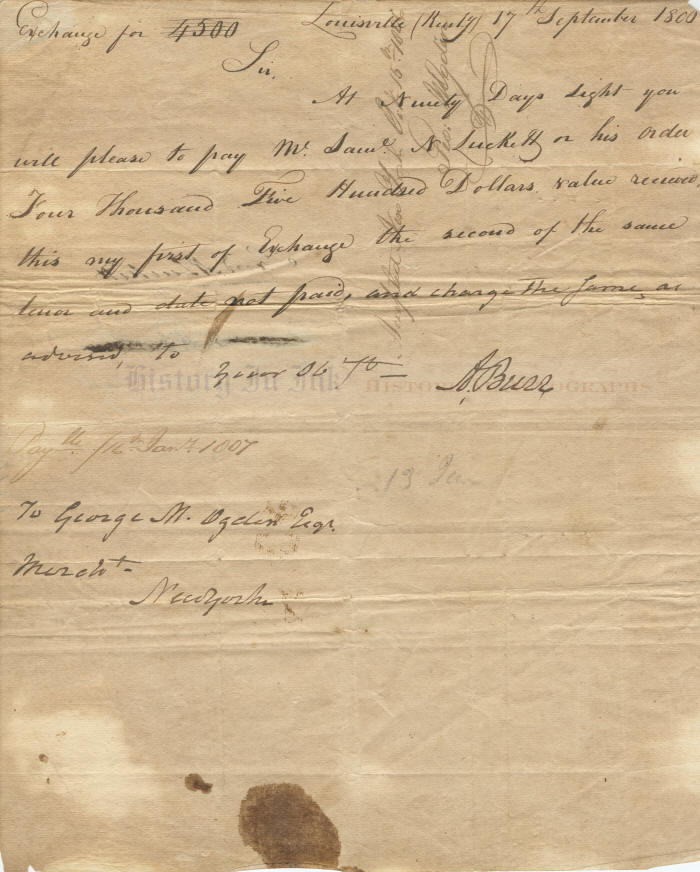2105901
Aaron Burr
Scroll down to see images of the item below the description
A rare and likely unique find—a bill of exchange from Burr, for nearly $100,000 today,
used to fund his allegedly treasonous plot to dismantle the Louisiana Territory and the American Southwest,
capture Spanish land in Florida, Texas, and Mexico, and create a new country under his own rule
Aaron Burr, 1756–1836. 3rd Vice President of the United States, 1801–1805; famous for killing Alexander Hamilton in an 1804 duel. Partially autograph manuscript document signed, A Burr, one page, 8” x 9¾”, Louisville, Kentucky, September 17, 1806.
This bill of exchange—a combination of a promissory note and a draft—is a rare and likely unique find. It represents financing for Burr’s allegedly treasonous actions to sever part of the United States in order to create a country of his own. We have found nothing comparable sold at auction. One has to wonder whether the existence of this document, if it had been known to the government at the time, would have changed history through a broader indictment of Burr for treason and a conviction instead of an acquittal.
Here Burr directs George M. Ogden of New York to pay $4,500 to Samuel N. Luckett in 90 days. Burr has added in his hand, “and charge the same, as ordered, to / Your ob svt / A Burr” and has also written the direction to Ogden with his name and address, “To George M. Ogden Esqr. / Mercht / New York.” Ogden has signed an acceptance signature vertically across the text, “Accepted New York Oct. 15th 1806,” and Luckett has signed on the back along with another signature that has been blotted out by ink.
Burr was arrested in early 1807 and indicted by a federal grand jury for treason on the ground that he intended “to raise and levy war, insurrection and rebellion against the United States” by assembling men at Blannerhasset’s Island, in the Ohio River in Virginia, and from there to navigate the Ohio and Mississippi Rivers to seize New Orleans from the United States. In 1803, when Burr was Vice President, France had sold the United States the Louisiana Territory, which stretched from New Orleans to the Pacific Northwest. In 1804, Burr secretly proposed to the British to divide Louisiana from the United States in exchange for $500,000 and British naval assistance, but the British declined. After he left office in 1805, Burr conceived a greater plan that even today is not entirely clear. The gist of the background for the treason charge, however, was that he intended to raise troops to capture New Orleans; incite a rebellion in Spanish-held parts of Florida, Texas, and Mexico and join them with land in the Louisiana Territory and the American Southwest, which he intended to sever from the United States; and establish a vast new country in the West—under his own rule, naturally.
George Ogden, the son of Burr’s cousin Matthias Ogden, “became the scheme’s banker.” David O. Stewart, Burr, Ogden and Dayton: The Original Jersey Boys, Smithsonian Magazine, Aug. 11, 2011 (online). Burr used bills of exchange such as this one to pay for boats, supplies, and even troops for the conspiracy. See David O. Stewart, American Emperor: Aaron Burr’s Challenge to Jefferson’s America 152–53, 156 (2011). Davis Floyd of Louisville, Kentucky, built boats for him. Id. at 153.
On July 29, 1806, Burr sent a ciphered letter to his co-conspirator General James Wilkinson, the head of the United States Army whom Burr had convinced President Thomas Jefferson also to appoint as Governor of the Louisiana Territory. Burr reported that he had “actually commenced the enterprise,” explaining that “detachments from different points and under different pretences will rendezvous on the Ohio” River on November 1 and would meet Wilkinson at Natchez, Mississippi, in early December. Burr told Wilkinson said that his “plan of operations is to move rapidly from the falls,” a direct reference to the Ohio River at Louisville, “on the 15th of November, with the first five hundred or one thousand men, in light boats now constructing for that purpose.”
When Burr returned to Kentucky in mid-September 1806 after a trip back east, he visited Louisville, Kentucky, and also Cincinnati, Ohio, and Nashville, Tennessee, while spending most of his time in Lexington and Frankfort, Kentucky. James E. Lewis Jr., The Burr Conspiracy: Uncovering the Story of an Early American Crisis 73 (2017). He was “dashing about from place to place in this country as if he had matters of great moment on hand.” Id. This bill of exchange is dated at Louisville on September 17, 1806, before Burr planned for his troops to leave for New Orleans on November 1. The face amount of this bill of exchange, $4,500, would be nearly $100,000 today.
Wilkinson, who received Burr’s coded letter by a private courier in October 1806, began to believe that Burr’s venture would fail. So, seeking to save his own hide, he exposed Burr. After omitting parts of the coded letter in order to clear himself, Wilkinson sent it to Jefferson, who then notified Congress and ordered Burr’s arrest.
Documents in the Library of Congress collection show that in May 1807, Wilkinson forwarded a report of a statement that he had obtained from a potential witness. He enclosed with it a “List of Witnesses to be Summond [sic] against Aaron Burr.” Two of the people named on the list, who are also named in this bill of exchange, were “Samuel N. R. Luckett, Falls of Ohio”—again a direct reference to Louisville, which was founded where it is because of the falls—and “Robert and A. Swartwout of N. York and Ogden of the Same Place.” (Emphasis added.) Samuel N. Luckett was indeed summoned as a witness on behalf of the United States when the trial began on August 3, 1807. David Robertson, 1 Trial of Aaron Burr for Treason 396–97 (1875).
The presence of Luckett and Ogden on this bill of exchange is convincing evidence that Burr signed it in connection with unspecified financing for the conspiracy. The date and place match up with the scheme, and there is no evidence that Burr was doing anything at the time other than pursuing the conspiracy.
Samuel Noland Luckett (ca. 1780–1823), the beneficiary of this bill of exchange, was a prominent, influential, and wealthy citizen of Louisville. He was born in Montgomery County, Maryland, around the time of the Revolutionary War and migrated to Jefferson County, Kentucky, which today is coextensive with the City of Louisville. He was married there on February 4, 1803. His wife died shortly after the birth of their first child, Noland. He remarried on October 3, 1808, in Jefferson County and had five additional children. Harry Wright Newman, The Lucketts of Portobacco 31–32 (1938). He was from a wealthy, slave-owning family, and was wealthy himself. He was a landowner; Kentucky court cases show that he acquired land originally owned by the trustees of the town of Louisville and acquired co-ownership of land from Transylvania University in Louisville. Allison v. Taylor’s Heirs, 42 Ky. 363, 364 (1843); Harrison’s Heirs v. Johnson, 13 Ky. 286, 286–87 (1823). He left his property to his wife and children at his death. Katharine G. Healy, Calendar of Early Jefferson County, Kentucky, Wills, 6 Filson Club History Q. 197 (1932) (Will Book No. 2, Part 1). His mother also left slaves to his children. Id. at 324–25 (Will Book No. 2, Part 2). Luckett was a Mason and served as the Junior Warden of the new Lodge Abraham # 8, Ancient Free and Accepted Masons, founded at Middletown, Kentucky, in 1802 and moved to nearby Louisville in 1803. He was also the co-administrator of the Estate of Judge Thomas T. Davis, a United States judge in the Indiana Territory. An Account of the Receipts and Expenditures of the United States, for the Year 1808, at 31 (1808). In an interesting twist of fate, Judge Davis presided over the trial in which Burr’s accomplice, the boat builder Davis Floyd mentioned above, was convicted of his involvement in the conspiracy, although treason charges against him were dropped.
The federal treason charge against Burr was lodged at Jefferson’s direction. The President, who already detested Burr, personally directed the prosecution from the White House. But Burr was acquitted by the jury on instructions from Chief Justice John Marshall, who did not believe that the narrow language of the indictment constituted treason under the United States Constitution. It did not hurt Burr that Marshall, who presided at the trial, and Jefferson, his distant cousin, also greatly disliked each other. The jury found that there was no evidence of insurrection against Burr, who was not present at Blannerhasset’s Island on the date charged in the indictment.
Our research has found no other Burr financial documents or other items from 1806 that have been sold at auction since 1975. We found only two other Burr items from the period in 1807 before Burr’s final arrest on treason charges. (Burr was arrested once but escaped and was arrested again on February 19, 1807.) A manuscript letter from Burr to Cowles Mead, the acting Governor of Mississippi, dated January 24, 1807, in which Burr requested a passport to protect his boats, brought $4,250 in November 2013, and an autograph letter signed by Burr ca. February 7, 1807, to Mississippi Governor Robert Williams, stating Burr’s conditions for his return into custody, brought $13,000 in 1992.
This bill of exchange has numerous intersecting folds and general toning with a few stains. There is minor paper loss at some of the fold intersections and at the top and bottom edges, including loss of the upper right corner, affecting part of the “6” in “1806” in the date. It is clear that the document is dated 1806, however, from other references in it, including Ogden’s notation “Accepted New York Oct. 15th 1806” and another notation in the middle that the money was “Payble 16th Jany 1807.” There is also some show through from a dark ink signature cancellation on reverse, and there are scattered small pinholes, none affecting Burr’s signature, which is isolated and bold. Overall the piece is in very good condition.
This document is exceptional. The fact we have found no other Burr items from the period of his traitorous scheme sold at auction since 1975 underscores just how rare and important this document is. It belongs in the finest of American historical collections.
Unframed.









